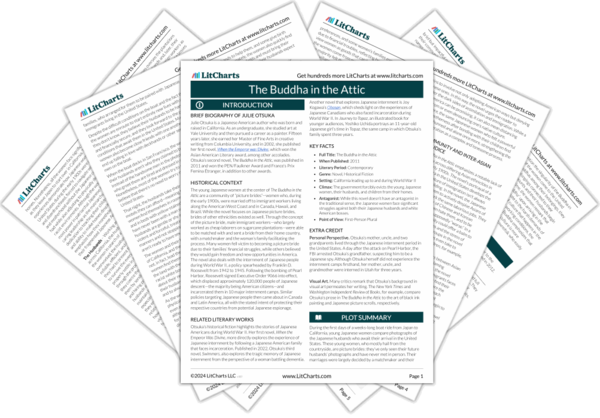Gender and Autonomy
The Buddha in the Attic explores the idea that, while the entire Japanese community in the United States suffered during the years leading up to Japanese internment, Japanese women who immigrated as “picture brides” experienced a heightened amount of isolation and violence, as well as an overall lack of autonomy within their own families and homes. Although the Japanese women in the novel look forward to the beautiful lives their husbands have promised them in…
read analysis of Gender and AutonomyRacism, Assimilation, and Cultural Identity
By portraying Japanese immigrants facing prejudice from both white Americans and their own Japanese American children, The Buddha in the Attic examines how widespread racist ideas prevented the flourishing of Japanese culture and identity during the early 1900s in California. While the novel builds up to the American government’s eventual internment of Japanese immigrants (which was an overt display of racist ideologies on an institutional level), it also sheds light on smaller-scale but nonetheless malicious…
read analysis of Racism, Assimilation, and Cultural IdentityCommunity and Inter-Asian Prejudice
The Buddha in the Attic emphasizes a notable lack of community across differing Asian ethnicities in California during the early 1900s. The novel’s portrayal of a fragmented Asian diaspora in the United States develops the idea that the high-stress nature of immigration isn’t always conducive to community-building. In the novel, the Japanese women and their husbands seem to actively despise Asians of other ethnicities, who often work the same laborious jobs. They warn their children…
read analysis of Community and Inter-Asian Prejudice
The Power of Collectivism
Japanese culture is known to be collectivist in nature, meaning that it tends to value the group over the individual. The group narration of The Buddha in the Attic reflects this in a powerful and nuanced manner, allowing the Japanese women—narrated as a collective “we”—to deliver their stories while also providing brief but impactful portraits of themselves as individuals in their community. While the reader might not always learn the names of specific Japanese…
read analysis of The Power of Collectivism






